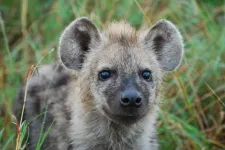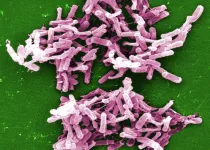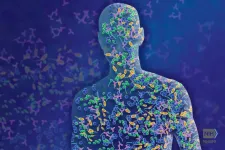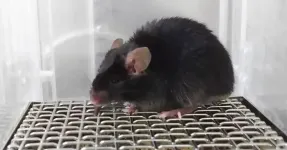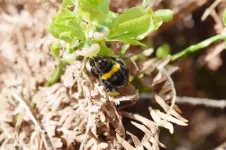(Press-News.org) Best known for its presence in house cats and a tendency to infect and alter the behaviors of rodents and humans, the parasite Toxoplasma gondii (T. gondii) is also associated with bold behavior among wild hyena cubs and risk of death during interactions with lions, finds new research from the University of Colorado Boulder.
The findings, published this week in Nature Communications, reinforce previous research which has found the parasite can prompt profound behavioral changes in its hosts, and potentially in the 2 billion people worldwide estimated to be infected by it. While T. gondii has been well studied in laboratory settings with humans and wild-caught rodents, this is one of the first studies to examine how the parasite effects wild host behavior during interactions with wild cats.
The research uses a rich data set from more than three decades of continuous field research in the Maasai Mara National Reserve in Kenya. It reveals that hyena cubs, but not subadult or adults, infected by T. gondii behave more boldly in the presence of lions, and that infected cubs have a greater risk of being killed by lions.
"This project is one of a handful of long-term continuous studies on a long-lived mammal," said Zach Laubach, co-lead author on the study and postdoctoral fellow in ecology and evolutionary biology. "Our findings suggest that infection early in life leads to bolder behavior and is particularly costly for young hyenas."
Many strains of T. gondii are found throughout the world, infecting warm blooded animals--including humans who have house cats--during different life stages through contaminated soil, drinking water or eating meat of other infected animals. It can also be passed down from mother to baby.
The researchers found that in the hyena populations they studied, infections are widespread but more common in older animals, meaning that it's most likely that they become infected by consuming contaminated meat or water.
For infected cubs--hyenas up to one year old--they found infected animals are bolder, approaching lions from closer distances than uninfected cubs, and that infection among cubs also corresponds to a higher probability of being killed by lions. In this study, lions were the responsible for all hyena cub deaths among infected animals, but only 17% of uninfected cubs died before the age of one due to lion attacks.
This is a vulnerable time in the life cycle of spotted hyenas, who despite being proficient hunters, take a long time to develop and rely on support and protection from their mothers, according to Laubach.
"Hyena moms invest a ton of both time and resources into their offspring. They nurse until they're about a year old and don't reach independence until they're about two or more years old," said Laubach. "But after they're one year old, we found no difference in how close they got to lions, regardless of infection status."
Some scientists theorize that this parasite manipulates its hosts' behavior (whether that host is a hyena or human) in order to get back to cats, where it can sexually reproduce. But the data from this study doesn't provide enough evidence to disentangle the theory supporting an adaptive mechanism for the parasite from other plausible alternative theories. It does, however, show that T. gondii has a direct and detrimental impact on hyena fitness.
Measuring the cost of confidence
Maasai Mara National Reserve is a biological hot spot in southwestern Kenya, between Lake Victoria and the bustling city of Nairobi. For more than 30 years now, the Mara Hyena Project, led by co-author Kay Holekamp, has been gathering data on the health and behavior of spotted hyenas in one of the best places in the world to study a diverse array of large, carnivorous mammals.
"It's really a one-of-a-kind system, especially for studying large carnivores in a natural setting, which is a rare opportunity," said Laubach. "I can't think of another place in the world where you can see the same numbers and diversity of species of large mammalian carnivores, it's pretty spectacular."
Laubach notes there are many misconceptions about hyenas. They're quite social and live in large groups, some with more than 120 individuals. They're also formidable in size and strength, at up to a 170 pounds when full grown (twice the size of a large dog) and they have one of the strongest jaws in the animal kingdom.
"They can eat bone, their bite can crack the femur of a giraffe," said Laubach.
Yet hyenas and lions compete with one another for territory and food, and these interactions with lions are the leading natural cause of hyena injuries and mortality.
Because previous research has shown that T. gondii can impact behavior in animals in laboratory settings, what the researchers wanted to know was: How does T. gondii affect wild hyenas' behaviors around lions, and what are the consequences?
Laubach and co-lead author Eben Gering analyzed archived data collect by numerous research assistants and graduate students. They gathered blood samples and documented the hyenas' interactions with each other and when they interacted with lions. From the safety of their vehicle, researchers Benson (Malit) Pioon and Holekamp of the Mara Hyena Project administered tranquilizers to 166 hyenas, in order to draw and test their blood for the parasite. They found 108, or 65%, had been previously exposed.
Over the years, researchers spent many hours each morning and evening out in the field, recording hyena behaviors of individuals that can be identified by their unique spot patterns on their coats. The data revealed that infection with the parasite T. gondii was related to boldness and greater risk of lion mortality among hyena cubs but not older animals. The lack of an effect in older animals could be because they've had time to learn, while cubs have less than one year of experience to compete with the influence of the parasite.
"One limitation of this work is that it was an observational study. But limitations are interesting, because it points to what one might do next," said Laubach. "We'd like to go back and tease apart how behaviors change in individuals by comparing how their behaviors differ before versus after infection."
INFORMATION:
Additional authors on this publication include Eben Gering of Michigan State University and Nova Southeastern University; Patty Sue Weber, Gisela Soboll Hussey and Thomas Getty of Michigan State University; Kenna Lehmann and Kay Holekamp of Michigan State University and the Mara Hyena Project; Tracy Montgomery of Michigan State University, the Mara Hyena Project and the Max Planck Institute of Animal Behavior; Julie Turner of Michigan State University, the Mara Hyena Project and the Memorial University of Newfoundland; Wei Perng of the Colorado School of Public Health, CU Denver Anschutz Medical Campus; and Malit Pioon of the Mara Hyena Project.
Researchers from Charité - Universitätsmedizin Berlin and the University of California in San Francisco were able to show for the first time that a very low calorie diet significantly alters the composition of the microbiota present in the human gut. In a current Nature* publication, the researchers report that dieting results in an increase of specific bacteria - notably Clostridioides difficile, which is associated with antibiotic-induced diarrhea and colitis. These bacteria apparently affect the body's energy balance by exerting an influence on the absorption of nutrients ...
WHAT:
National Institutes of Health scientists and their collaborators have identified an internal communication network in mammals that may regulate tissue repair and inflammation, providing new insights on how diseases such as obesity and inflammatory skin disorders develop. The new research is published in Cell.
The billions of organisms living on body surfaces such as the skin of mammals--collectively called microbiota--communicate with each other and the host immune system in a sophisticated network. According to the study, viruses integrated in the host genome, remnants of previous infections called endogenous retroviruses, can ...
Researchers at the RIKEN Center for Brain Science and the RIKEN BioResource Research Center in Japan, along with collaborators at the State University of New York at Buffalo, have created a mouse model that allows the study of naturally occurring melatonin. Published in the Journal of Pineal Research, these first experiments using the new mice showed that natural melatonin was linked to a pre-hibernation state that allows mice to slow down their metabolism and survive when food is scarce, or temperatures are cold.
Melatonin is called "the hormone of darkness" because it's released by the brain in the dark, which usually means at night. It tells the body when it's dark outside so that the body can switch to 'night mode'. Although other hormones are easily studied in the laboratory, ...
How many tree species are there in the forest? How are the trees scattered throughout? How high are the individual tree crowns? Are there fallen trees or hollowed-out tree trunks? Forest scientists characterize forests according to structural factors. "Structural richness is very important for biodiversity in forests. But forests used for forestry are generally poor in terms of structure," says Tristan Eckerter from the Chair of Nature Conservation and Landscape Ecology at the University of Freiburg. Therefore, together with research teams from the Chair of Silviculture and the Black Forest National Park, he investigated ...
A new article published in the Journal of the Association for Consumer Research presents a neural model of maladaptive consumption.
Consumption (of, for instance, substances, food, and online media) is driven mainly by expected rewards that stem from the ability of the consumption act to satisfy intrinsic (e.g., curiosity) and extrinsic (e.g., job performance) needs. In the article, "A Triple-System Neural Model of Maladaptive Consumption," the authors define maladaptive consumption as a state of compulsive seeking and consumption of rewarding products or experiences, which are sustained despite the negative consequences of such behaviors.
"Understanding the neural basis of maladaptive ...
Pairing blueberry pie with a scoop of ice cream is a nice summer treat. Aside from being tasty, this combination might also help people take up more of the "superfruit's" nutrients, such as anthocyanins. Researchers reporting in ACS' Journal of Agricultural and Food Chemistry show that α-casein, a protein found in cow's milk, helped rats absorb more blueberry anthocyanins and their byproducts, boosting accessibility to these good-for-you nutrients.
In studies, anthocyanins have been shown to have antioxidant properties, lower blood pressure and reduce the risk of developing some cancers. However, only small amounts of these nutrients are absorbed ...
For patients who have inflammatory bowel syndrome (IBS), the condition is literally a pain in the gut. Chronic -- or long-term -- abdominal pain is common, and there are currently no effective treatment options for this debilitating symptom. In a new study in ACS Pharmacology & Translational Science, researchers identify a new potential source of relief: a molecule derived from spider venom. In experiments with mice, they found that one dose could stop symptoms associated with IBS pain.
The sensation of pain originates in electrical signals carried from the body to the brain by cells called ...
Air quality varies greatly within regions and cities around the world, and exposure to air pollution can have severe health impacts. In the U.S., people of color are disproportionately exposed to poor air quality. A cover story in Chemical & Engineering News, the weekly newsmagazine of the American Chemical Society, highlights how scientists and community activists are using new technologies to gather data that could help address this inequity.
Despite the success of the U.S. Clean Air Act in improving ambient air quality over the past 50 years, discriminatory housing, loan ...
Over recent years, the retina has established its position as one of the most promising biomarkers for the early diagnosis of Alzheimer's. Moving on from the debate as to the retina becoming thinner or thicker, researchers from the Universidad Complutense de Madrid and Hospital Clínico San Carlos are focusing their attention on the roughness of the ten retinal layers.
The study, published in Scientific Reports, "proves innovative" in three aspects according to José Manuel Ramírez, Director of the IIORC (Ramón Castroviejo Institute of Ophthalmologic Research) at the UCM. "This is the first study to propose studying the roughness of the retina and its ten constituent layers. They have devised a mathematical method to measure the degree of wrinkling, through the fractal ...
Children with obstructive sleep apnea are nearly three times more likely to develop high blood pressure when they become teenagers than children who never experience sleep apnea, according to a new study funded by the National Heart, Lung, and Blood Institute (NHLBI), part of the National Institutes of Health. However, children whose sleep apnea improves as they grow into adolescence do not show an increased chance of having high blood pressure, which is a major risk factor for heart disease.
The long-term study, one of the largest of its kind in the pediatric population, underscores the seriousness of sleep apnea in children and the importance of early treatment, the researchers said. Their findings appear online in the journal JAMA Cardiology.
Obstructive sleep apnea, ...
